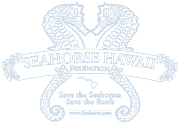Ocean Rider Seahorse Farm and Tours | Kona Hawaii › Forums › Seahorse Life and Care › bloating › Re:bloating
Dear Teresa:
I’m sorry to hear that your seahorse has developed problems with positive buoyancy. I assume that your seahorse is a male and that his pouch has become bloated due to gas or air that has become trapped or accumulated within the marsupium. This is a fairly common problem with male seahorses, and you’ll need to remove the trapped gas or air by "burping" or massaging his pouch or by performing a pouch flush, as discussed below:
First I’ll outline the treatment protocol I recommend in cases like this, Teresa, and then I’ll explain some of the ways to evacuate the air from your male’s pouch:
First Treatment: Manually Evacuating Gas from the Pouch
At the first sign of a bloated pouch accompanied by any indications of positive buoyancy, the pouch should be "burped" or the trapped gas should be evacuated using a fine catheter. That will provide the affected seahorse with immediate relief, and if this simple first-aid measure resolves the issue, all is well and good.
In that case, the problem was no doubt due to simple pouch bloat, a harmless sort of gas build up that is entirely unrelated to chronic pouch emphysema. Pouch bloat can be caused by gas produced by the decay of embryonic material and the remains of placental tissue or other organic matter (possibly even stillborn young) within the brood pouch, if the male is unable to flush it out and cleanse it properly by pumping water in and out during its pouch displays (Cozzi-Schmarr, per. com.). And in some isolated cases, it’s possible that a bacterial infection of the pouch may also be involved (Cozzi-Schmarr, 2003). But it is far more common for pouch bloat to result from air bubbles trapped in the pouch during courtship displays, especially if the male chooses to display in the bubble stream produced by an airstone or bubble wand or bubble curtain (Strawn, 1954)..
However, hobbyists should be aware that even a case of simple pouch bloat can contribute to recurring pouch emphysema, a much more serious problem, if it is not handled properly. The simple act of of struggling against the positive buoyancy that results from pouch bloat can alter the seahorse’s blood chemistry, and result in full-blown PE via acidosis of the blood if the problem is not relieved promptly.
The first indication of both pouch bloat and PE is a loss of equilibrium. The seahorse’s center of gravity shifts as the gas accumulates in its pouch, and it will have increasing difficulty swimming and maintaining its normal posture, especially if it encounters any current. It will become apparent that the seahorse has to work hard to stay submerged, as it is forced to abandon its usual upright swimming posture and swim with its body tilted forward or even horizontally in order to use its dorsal fin to counteract the tendency to rise.
The uncharacteristically hard work it must do while swimming means the hard-pressed seahorse builds up an oxygen debt in its muscles, and the lactic acid that builds up as a result of anaerobic metabolism further disrupts its blood chemistry and worsens the situation. It will struggle mightily in a losing battle against its increasing buoyancy until finally it can no longer swim at all, bobbing helplessly at the surface like a cork whenever it releases its grip on its hitching post. At this point, its pouch will be obviously swollen and bloated.
It is imperative that the gas be evacuated and neutral buoyancy restored long before that happens in order to assure that the affected seahorse is subjected to the least possible stress and does not have to overexert itself for an extended period. The longer it must fight against positive buoyancy, the greater the chances its blood will be acidified in the process and the more likely it becomes that a case of basic pouch bloat can progress into recurring pouch emphysema.
Breeding males are often especially susceptible to chronic pouch emphysema and GBS in general because of the placenta-like changes that occur in the lining of the pouch during pregnancy. Spongelike, its tissues expand as the capillaries and blood vessels swell and multiply. A film of tissue then forms around each embedded egg, providing it with a separate compartment (alveolus) of its own. The thickening of the wall of the marsupium and elaboration of pouch structures around the implanted eggs result in a dramatic increase in vascularization, and this increased blood supply (hence increased concentration of carbonic anhydrase) transports more dissolved gases to the pouch, increasing the risk of GBS accordingly.
Ideally, the air should be evacuated from the male’s pouch at the first sign of positive buoyancy. If this simple procedure does not cure the problem, then it is appropriate to move on to stronger measures once the problem recurs, as described below.
Second Treatment: Flushing the Pouch combined with administering Acetazolmide orally.
In my experience, acetazolmide (brand name Diamox) is much more effective in treating PE when it is ingested rather than administered as a pouch flush or a series of baths. Therefore, if pouch gas recurs a second time, I recommend treating it more aggressively with antibiotic/antifungal pouch washes while feeding the affected seahorse Diamox-injected shrimp (or Diamox bioencapsulated in live shrimp, depending on how badly handicapped the buoyant male happens to be when it comes to feeding).
The pouch flush solution I prefer is a combination of nifurpirinol and neomycin sulfate, since that combo works together synergistically to forms a wide spectrum antibiotic with potent antifungal as well as antibacterial properties (Basleer, 2000). Nifurpirinol (Furanase) and neomycin sulfate (Neosulfex) are the active ingredients in two different commercial products designed for aquarium use, and both of them used to be readily available at your local fish store. Neosulfex has since been discontinued, I believe, but neomycin sulfate is still found in many aquarium medications and is also available online from the National Fish Pharmacy.
Because it is so difficult to distinguish chronic pouch emphysema (PE) from ordinary pouch bloat, which has virtually identical symptoms, many seahorse keepers delay treatment too long when their prize ponies are experiencing buoyancy problems. They will often continue to evacuate the air from the pouch repeatedly in the forlorn hope that their stallion has not developed a life-threatening form of GBS but merely trapped a little air during his pouch displays. Very often this is wishful thinking, which only delays the inevitable and subjects the seahorse to ongoing stress needlessly, while making successful treatment more difficult by increasing the risk that gas emboli will form elsewhere and cause more damage in the meantime. In many cases, all you accomplish by waiting and hoping for the best is to allow the PE to become more advanced, more entrenched, and more severe in the interim.
To avoid this sort of needless delay, I suggest flushing the pouch thoroughly with antibiotics at the first sign of pouch gas and positive buoyancy should your initial attempt to evacuate the air fail to cure the problem (Garrick-Maidment, pers. com.). The affected seahorse must be handled in order to "burp" its pouch or evacuate the air via pouch massage anyway, so I recommend administering an antibiotic pouch wash at the same time.
Not only is repeatedly evacuating the air from the male’s pouch counterproductive in most cases, the constant manipulation can be hard on the tissue of the pouch, aggravating the dermal layers of the marsupium and leaving them vulnerable to secondary infections. (The male marsupium is far more complex than most hobbyists realize, consisting of four separate layers of epithelial and connective tissue, with the innermost layers being heavily vascularized.)
The skin or integument of the pouch is of course its first line of defense against disease. It contains mucus glands, and the slime covering the skin acts as a barrier to ectoparasites and infection. The protective slime may even contain antibodies and antibacterial substances (Evans, 1998). Marine fish are always in danger of dehydration because the seawater they live in is saltier than their blood and internal body fluids (Kollman, 1998). As a result, they are constantly losing water by diffusion through their gills and the surface of their skin, as well as in their urine (Kollman, 1998). The mucus layer also acts as a barrier against this, waterproofing the skin and reducing the amount of water that can diffuse through its surface (Kollman, 1998).
Repeatedly burping or massaging the pouch removes this protective barrier, and the shearing pressures that are involved may aggravate the underlying tissue, resulting in secondary infections of the outer marsupium that can further complicate the picture.
Progressing directly to flushing the pouch plus oral Diamox after the first pouch evacuation helps minimize these repeated insults to the delicate marsupium.
Third Treatment:
If all goes well, as it usually does when the proper measures are performed in a timely fashion, a third round of treatments is normally not necessary. In fact, some experts report a 100% cure rate for pouch emphysema when such pouch flushes are properly administered during the early stages of the condition (Garrick-Maidment, per. com.).
However, if the pouch flushes and an oral Diamox should fail to resolve the problem, the recompression-decompression cure would be your next recourse. Paul Groves found pressurization to be an effective cure for pouch emphysema, as well as the other forms of GBS, while he was conducting his extensive series of trials with gas bubble syndrome.
And if they happen to have the necessary equipment already on hand, some hobbyists prefer to treat PE with recompression-decompression as their second form of treatment, skipping over the Diamox and pouch flushes altogether. I have not tried the latter personally, however.
OK, Teresa, here are some instructions on how to carry out that first treatment to evacuate the air from your male’s pouch. That should provide him with some immediate relief and hopefully no other treatments will be necessary.
Pouch Massage: Burping the Pouch
Pouch bloat is ordinarily easily resolved by evacuating the gas from the marsupium. This procedure is commonly known as pouch massage or "burping" the pouch and it provides immediate relief for the seahorse when successful. The first attempt or two at performing this procedure can be very intimidating, I know, but it is actually much easier than it sounds.
To expel the trapped air, wet your hands first and hold the seahorse upright in the water with your non-dominant hand, allowing his tail to wrap your little finger or ring finger so he has a good grip and feels secure (Burns, 2001). While the seahorse is thus restrained, use your dominant hand to massage the pouch firmly yet gently between your index finger and thumb, working upward with a circular motion from the bottom of the tail toward the top so as to work the trapped gas upwards toward the opening of the pouch (Burns, 2001). Don’t squeeze the pouch too forcibly, just maintain gentle pressure from below as you massage the pouch, always working from the base of the pouch toward the orifice at the top with your thumb and index finger to force the gas upward.
Hopefully, as your massage moves to the upper half of the pouch and approaches the top, the aperture of the pouch will begin to gape open, allowing a stream of bubbles to escape (Burns, 2001). This is the "burp" you’ve been hoping to produce, and when it happens, you can actually feel the bloated pouch slowly deflate as you gently force the bubbles out (Burns, 2001).
If that does not happen, however, you will have to modify your gas evacuation technique somewhat, this time using the thumb and index finger of your non-dominant hand to massage the pouch with a gentle back and forth motion, while you use a bobby pin or similar blunt implement in your dominant hand to carefully tease open the aperture of the pouch (Burns, 2001).
You are not trying to insert the bobby pin into the pouch at all (Burns, 2001). The idea is to use the rubber-coated end of the pin to gently manipulate the orifice of the pouch, using a sideways pressure on the mouth of the pouch to tease it open, rather than using a downward pressure to force the bobby pin into the opening (Burns, 2001).
Begin as before, holding the seahorse upright in the water with your non-dominant hand, allowing his tail to wrap your little finger or ring finger so he has a good grip and feels secure, while leaving your thumb and index finger free to perform the massage (Burns, 2001). Begin at the base of the pouch near the tail, and massage the pouch gently but firmly between your thumb and index finger, working upwards with a back and forth motion as though gently squeezing a toothpaste tube from the bottom to the top (Burns, 2001).
Meanwhile, using your dominant hand, position one of rubber coated ends of the booby pin at the mouth of the slitlike aperture, and use sideways pressure to prise the lips of the pouch open without actually inserting the pin into the pouch (Burns, 2001). This may take a surprising amount of pressure, so proceed gently but firmly, making sure you direct the brunt of the pressure sideways rather than downward (Burns, 2001). As your massage progresses to the upward portion of the pouch, a few small bubbles at a time will be expelled, and you can feel the pouch gradually deflate between your fingers.
Continue applying pressure from the bottom of the pouch up while prizing the mouth of the pouch open until the pouch feels flaccid and no more gas escapes (Burns, 2001). You may have to repeat this procedure two or three times to be sure you have evacuated all of the trapped gas (Burns, 2001).
If successful, it’s an instant cure and your seahorse should be back to normal immediately, able to swim freely and feed as usual. Burping the pouch is stressful, but seahorses are very forgiving and often will swim away and start eating immediately afterward as though nothing happened. This type of pouch gas is not a serious problem and poses no threat to the seahorse’s long-term health.
Eyedropper Pouch Evacuations
Rather than burping or massaging the pouch, some hobbyists find it easier to use an ordinary eyedropper to evacuate the air from a large seahorse’s pouch. This technique is fairly self-explanatory. Get a glass eyedropper (the smaller the better) from your drugstore — the glass kind that has a rubber bulb. The glass tip is much smoother than plastic droppers are and the rubber squeeze-bulb allows you to apply suction using the eyedropper with one hand while holding the seahorse with your other hand.
Take the seahorse in your nondominant hand, keeping it underwater, of course, and let it wrap its tail round your baby finger. Then take the eyedropper in your dominant hand, squeeze the rubber bulb and hold the bulb squeezed closed while you very gently insert the glass tip into the aperture of the pouch. Once you are just slightly inside the pouch, slowly release the squeeze bulb and the bubbles of trapped air will often be aspirated.
Remove the eyedropper, expel the bubbles it extracted, and repeat the whole procedure as necessary to remove all the trapped air and restore neutral buoyancy.
If you have a Pouch Kit from Ocean Rider, the flushing apparatus can be used in a similar manner to aspirate the trapped air.
Needle Aspirations.
It is also very practical to aspirate air from a bloated pouch using a small hypodermic needle and a syringe. The pouch can easily be penetrated from side and is not harmed by the entrance of the needle. It causes the seahorse surprisingly little discomfort and is often less traumatic that massaging the pouch and other methods for evacuating gas. It is a quick and effective technique and is often easier on the seahorse keeper and his patient than other approaches.
Whatever method you decide to use to evacuate the male’s pouch, be sure to observe the following precautions when manipulating seahorses:
Handling Seahorses
I do not like to use an aquarium net to transfer or manipulate seahorses, since their delicate fins and snouts can become entangled in the netting all too easily. I much prefer to transfer the seahorses by hand. Simply wet your hand and fingers (to avoid removing any of the seahorse’s protective slime coat) and scoop the seahorses in your hand. Allow them to curl their tail around your fingers and carefully cup their bodies in your hand to support them while you lift them out of the water. When you gently immerse your hand in the destination tank, the seahorse will release its grip and swim away as though nothing out of the ordinary has happened.
Composed of solid muscle and endowed with extraordinary skeletal support, the prehensile tail is amazingly strong. Indeed, large specimens have a grip like an anaconda, and when a 12-inch ingens or abdominalis wraps its tail around your hand and tightens its hold, its vise-like grip is powerful enough to leave you counting your fingers afterwards!
In fact, it can be quite difficult to remove an attached seahorse from its holdfast without injuring it in the process. Never attempt to forcibly detach a seahorse from its hitching post! When it feels threatened, it’s instinct is to clamp down and hold on all the tighter. When you must dislodge a seahorse from its resting place for any reason, it’s best to use the tickle technique instead. Gently tickling the underside of the tail where it’s wrapped around the object will usually induce the seahorse to release its grip (Abbott, 2003). They don’t seem to like that at all, and will quickly let go to move away to another spot. Once they are swimming, they are easy to handle.
Best of luck treating your male’s buoyancy problem, Teresa! Let me know if completely evacuated the air from his pouch resolves the problem or if his buoyancy problems come back. If the problem recurs, it may be necessary to treat him with Diamox and pouch washes in the next step, and I will be happy to provide you with complete instructions display name exactly how to do so.
Respectfully,
Pete Giwojna




